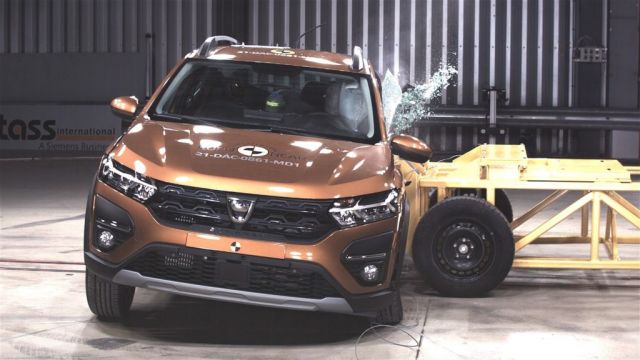Euro NCAP, the independent crash test safety expert organisation, is coming under fire for awarding the new Dacia Jogger MPV a one-star rating. It’s not specifically the rating that is bothering many, but the way in which NCAP came to its conclusions.
In essence, NCAP hasn’t actually tested the Jogger. Instead, it previously tested the mechanically-related Dacia Sandero, and has — with some extra data from Dacia itself, and some calculation work — extrapolated the Sandero’s results out to the Jogger.
Differences
There seem to be two immediate and obvious problems with that. First, as any scientist or engineer will tell you, you can do all the calculation and extrapolation you like, but there is absolutely no substitute for real-world testing. Second, while the Sandero and Jogger are indeed mechanically similar, one is a compact hatchback, while the other is a larger, seven-seat SUV-MPV, and there is a significant 200kg weight difference between the two.
We approached Euro NCAP for clarification on how the Jogger’s measly one-star score was achieved, and what this means for other cars, given that structural and mechanical commonality across many models and brands is now an industry standard.
Donna Hovsepian, EuroNCAP’s communications manager, said: “Euro NCAP performed some additional active safety tests to confirm that the Jogger performs the same as the Sandero.
"For the passive safety side of things [passive safety is how a car performs in a physical impact], we did not perform any full scale tests on the Jogger. For this part we asked Dacia for in-house full-scale crash test data for the Jogger, vehicle specification information comparing the Sandero vs the Jogger including mass, ride heights, CAD overlay drawings comparing both models, and trying to identify major differences.
"We would look deeply into this data to satisfy ourselves that no crash tests are needed when we are looking to apply the star rating from one model to another similar model. If we are not satisfied, we would carry out the crash tests but in the case of the Jogger, considering all the in-house data that we looked through, there was no need to proceed with the crash tests in this case. This is not always the case.”
Can of worms?
Does this, we asked, open up a potential can of worms in terms of how safety ratings are awarded? After all, vehicles that share a common structure and mechanical components can vary widely in their actual physical design — a VW Golf shares an awful lot with the much larger Passat, or even Tiguan for example. Are we to now assume that one baseline test covers all?
“No, this is treated on a case-by-case basis” said Hovespian. “The onus is on the car manufacturer to prove they are similar. If we have any doubt we test and if not selected for testing then no rating is allowed to be used for that variant. We are not extrapolating results. The heavier Jogger actually performed slightly better in two of the full scale tests than the Sandero. We don’t just look at a variant model and think ‘yeah, sure it looks the same it is probably the same result.’"
While this should be reassuring, it’s not the first time that NCAP has come under fire in recent years. Significant increases in the cost of new cars have been attributed, in large part, to the requirements to fit more and more high-end safety equipment. In some cases, this is at the behest of governments or the EU, but in others it’s a way for manufacturers to ensure that they get that important five-star rating.
Rising prices
However, there are criticisms that NCAP is influencing car makers to fit increasing levels of expensive equipment that is in large part not that useful to the average driver. David Zipper, a visiting fellow at the Harvard Kennedy School's Taubman Center for State and Local Government, wrote recently that: “Counterintuitively, some speculate that safer cars make streets more hazardous for pedestrians and cyclists, because drivers — secure in their increasingly impregnable machines — are more likely to take risks.”
Dacia seems to have taken the rating on the chin. Dacia Ireland would not respond directly to questions on the subject, and instead directed us to a central response from head office. That official response stated, as expected, that the Jogger is a safe car, and pointed out that in a physical crash test, it would have scored 70 per cent for adult occupant protection, and 69 per cent for child occupant protection.
Where it loses stars, says Dacia, is not in how it deals with an actual impact, but in the amount of high-end safety tech that’s not fitted as standard, and because it does not have a seatbelt reminder alarm for the third row of seats.
Interestingly, the company says that it will not be drawn into an NCAP arms race, saying: “We will not chase Euro NCAP stars. As a car maker, Dacia’s objective has always been to produce vehicles that meet the expectations of our customers: modern, affordable and fully compliant with European regulations. The Jogger is a safe new C-segment car that's homologated and compliant with European safety regulations. It's safe and protects occupants to a high standard.”
The debate now is less about whether or not the Jogger itself is safe or not (it is for its occupants, certainly more so than some of the older cars from which owners may well be moving) but about how much faith we can now put in Euro NCAP’s ratings. The mere fact of extrapolation of results may well undermine the scientific accuracy of those tests in many people’s minds, while the fact that NCAP is indirectly contributing to the rise and rise of new car prices may well also give pause.
Writing in Car Magazine, journalist Tom Wiltshire gave NCAP both metaphorical barrels: “Five-star verdicts are becoming harder to come across without the fitment of numerous expensive, complex systems that, while they may work well in a test scenario, can actually be irritating or even dangerous in some road conditions” he said.
“The organisation’s dogged focus on these driver assistance systems means it’s unfairly penalising cheap cars of the sort that are vital during a cost-of-living crisis. Personally, I’d like to see the existing system replaced with two scores – one indicating the car’s performance in an actual crash, and another rating its safety assist and crash protection systems. After all, if you're going to be crushed between a lorry and the central reservation, it’s the former you’d be concerned about.”







